warning TOYOTA C-HR 2020 Warranties & Maintenance Guides (in English)
[x] Cancel search | Manufacturer: TOYOTA, Model Year: 2020, Model line: C-HR, Model: TOYOTA C-HR 2020Pages: 260, PDF Size: 8.54 MB
Page 78 of 260
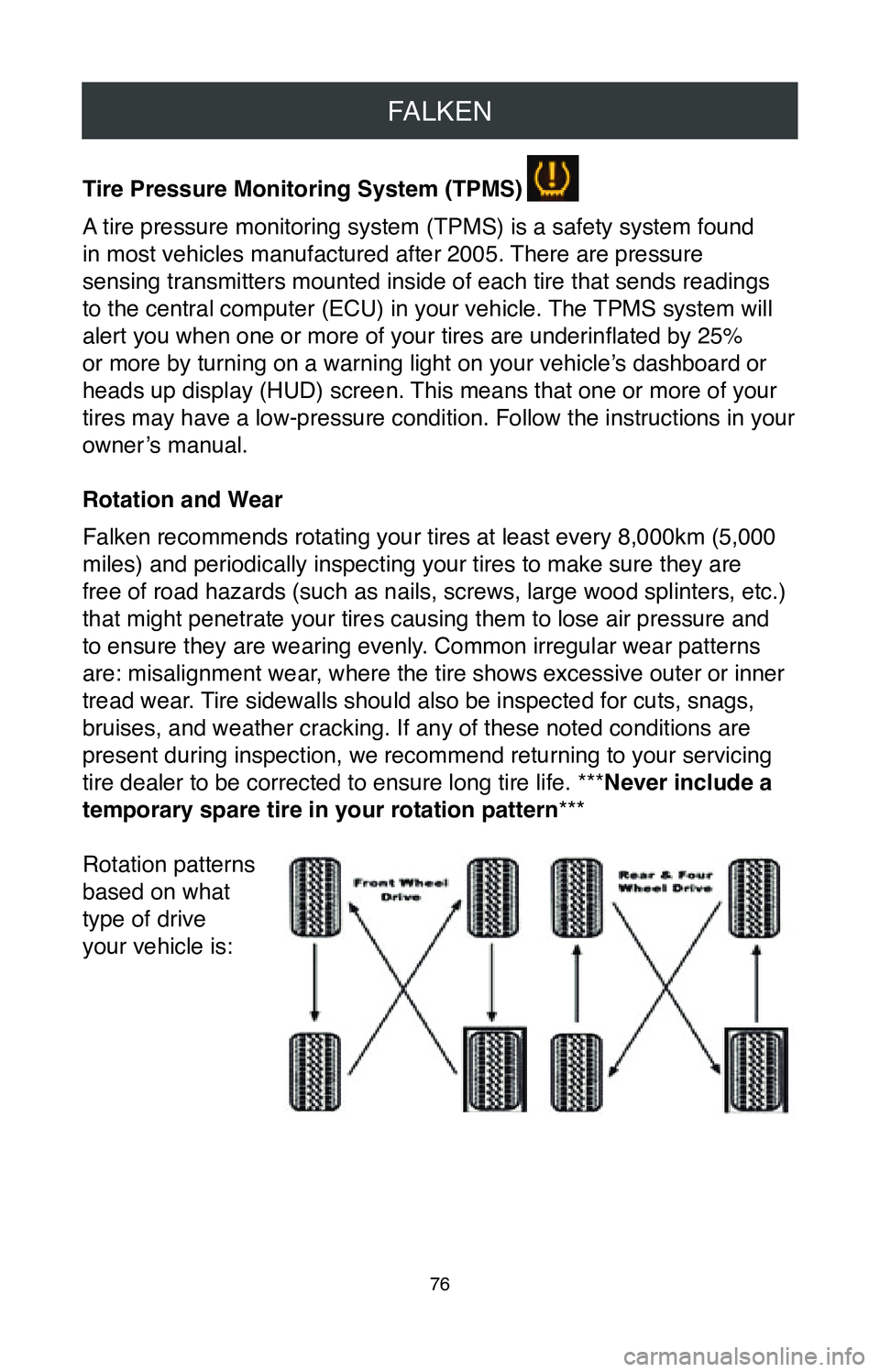
FALKEN
76
Tire Pressure Monitoring System (TPMS)
A tire pressure monitoring system (TPMS) is a safety system found
in most vehicles manufactured after 2005. There are pressure
sensing transmitters mounted inside of each tire that sends readings
to the central computer (ECU) in your vehicle. The TPMS system will
alert you when one or more of your tires are underinflated by 25%
or more by turning on a warning light on your vehicle’s dashboard or
heads up display (HUD) screen. This means that one or more of your
tires may have a low-pressure condition. Follow the instructions in your
owner’s manual.
Rotation and Wear
Falken recommends rotating your tires at least every 8,000km (5,000
miles) and periodically inspecting your tires to make sure they are
free of road hazards (such as nails, screws, large wood splinters, etc.)
that might penetrate your tires causing them to lose air pressure and
to ensure they are wearing evenly. Common irregular wear patterns
are: misalignment wear, where the tire shows excessive outer or inner
tread wear. Tire sidewalls should also be inspected for cuts, snags,
bruises, and weather cracking. If any of these noted conditions are
present during inspection, we recommend returning to your servicing
tire dealer to be corrected to ensure long tire life. ***Never include a
temporary spare tire in your rotation pattern***
Rotation patterns
based on what
type of drive
your vehicle is:
Page 80 of 260
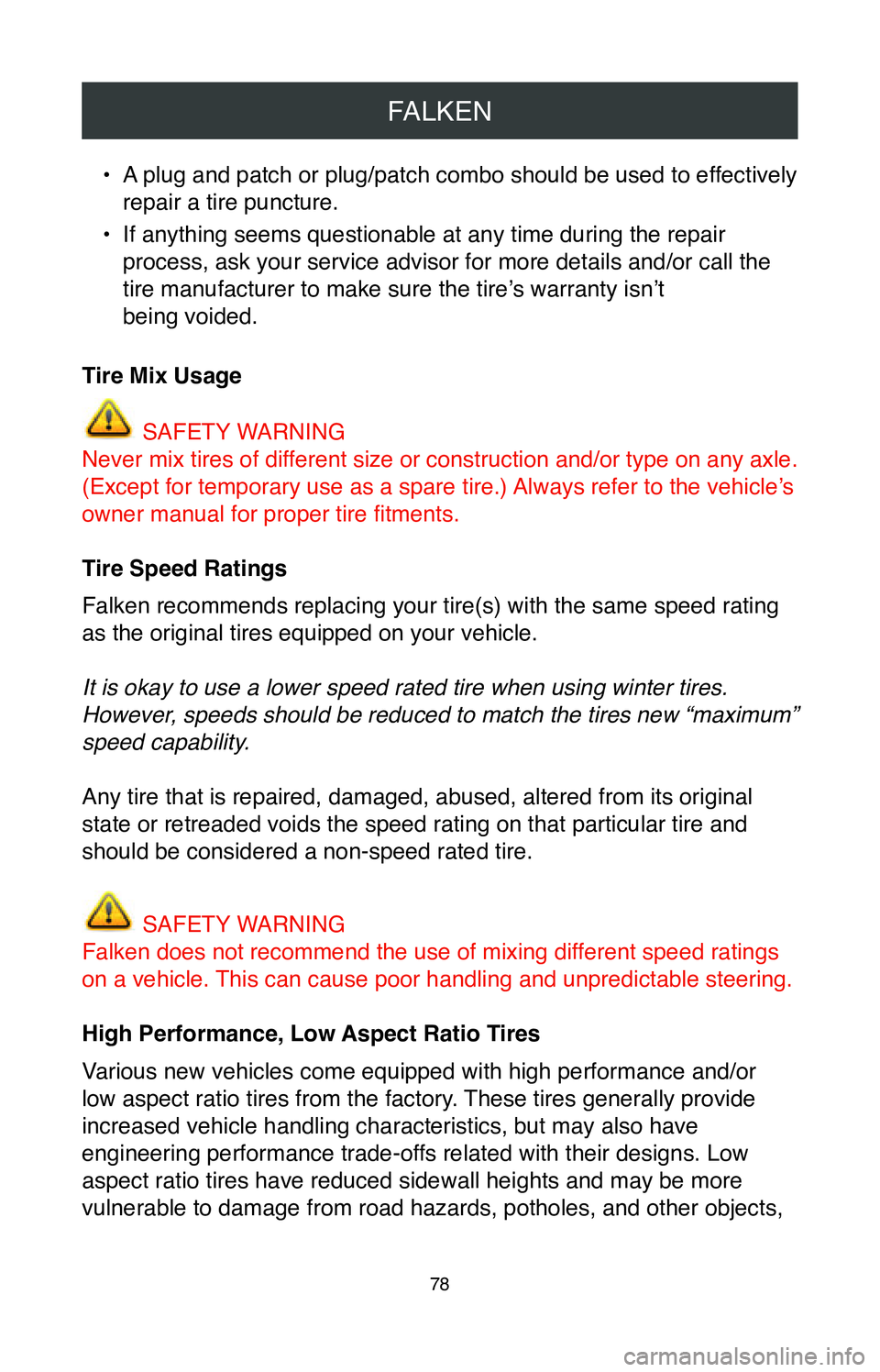
FALKEN
78
• A plug and patch or plug/patch combo should be used to effectively
repair a tire puncture.
•
If anything seems questionable at any time during the repair
process, ask your service advisor for more details and/or call the
tire manufacturer to make sure the tire’s warranty isn’t
being voided.
Tire Mix Usage
SAFETY WARNING
Never mix tires of different size or construction and/or type on any axle.
(Except for temporary use as a spare tire.) Always refer to the vehicle’s
owner manual for proper tire fitments.
Tire Speed Ratings
Falken recommends replacing your tire(s) with the same speed rating
as the original tires equipped on your vehicle.
It is okay to use a lower speed rated tire when using winter tires.
However, speeds should be reduced to match the tires new “maximum”
speed capability.
Any tire that is repaired, damaged, abused, altered from its original
state or retreaded voids the speed rating on that particular tire and
should be considered a non-speed rated tire.
SAFETY WARNING
Falken does not recommend the use of mixing different speed ratings
on a vehicle. This can cause poor handling and unpredictable steering.
High Performance, Low Aspect Ratio Tires
Various new vehicles come equipped with high performance and/or
low aspect ratio tires from the factory. These tires generally provide
increased vehicle handling characteristics, but may also have
engineering performance trade-offs related with their designs. Low
aspect ratio tires have reduced sidewall heights and may be more
vulnerable to damage from road hazards, potholes, and other objects,
Page 81 of 260
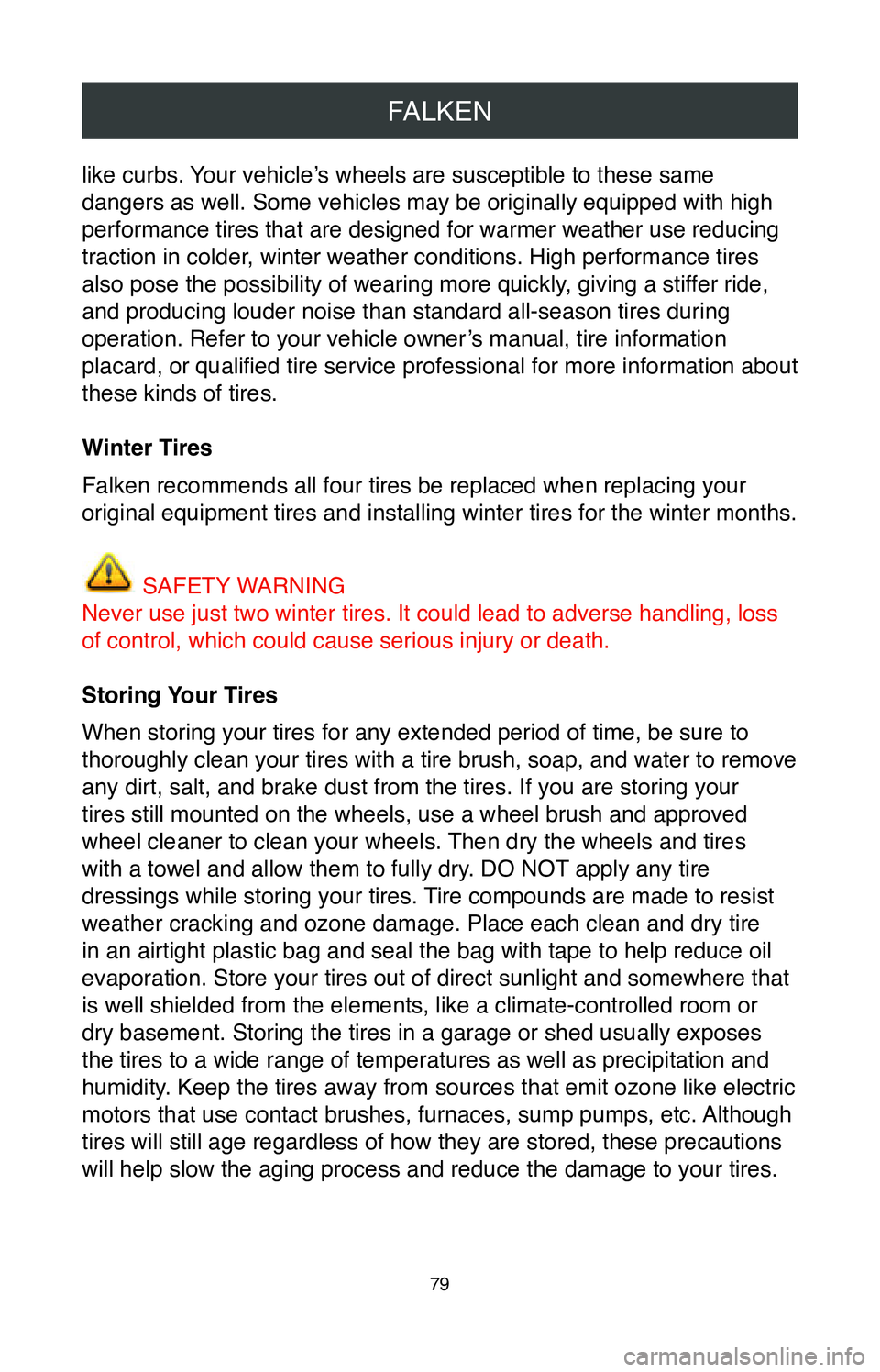
FALKEN
79
like curbs. Your vehicle’s wheels are susceptible to these same
dangers as well. Some vehicles may be originally equipped with high
performance tires that are designed for warmer weather use reducing
traction in colder, winter weather conditions. High performance tires
also pose the possibility of wearing more quickly, giving a stiffer ride,
and producing louder noise than standard all-season tires during
operation. Refer to your vehicle owner’s manual, tire information
placard, or qualified tire service professional for more information about
these kinds of tires.
Winter Tires
Falken recommends all four tires be replaced when replacing your
original equipment tires and installing winter tires for the winter mont\
hs.
SAFETY WARNING
Never use just two winter tires. It could lead to adverse handling, loss
of control, which could cause serious injury or death.
Storing Your Tires
When storing your tires for any extended period of time, be sure to
thoroughly clean your tires with a tire brush, soap, and water to remove\
any dirt, salt, and brake dust from the tires. If you are storing your
tires still mounted on the wheels, use a wheel brush and approved
wheel cleaner to clean your wheels. Then dry the wheels and tires
with a towel and allow them to fully dry. DO NOT apply any tire
dressings while storing your tires. Tire compounds are made to resist
weather cracking and ozone damage. Place each clean and dry tire
in an airtight plastic bag and seal the bag with tape to help reduce oil\
evaporation. Store your tires out of direct sunlight and somewhere that \
is well shielded from the elements, like a climate-controlled room or
dry basement. Storing the tires in a garage or shed usually exposes
the tires to a wide range of temperatures as well as precipitation and
humidity. Keep the tires away from sources that emit ozone like electric
motors that use contact brushes, furnaces, sump pumps, etc. Although
tires will still age regardless of how they are stored, these precaution\
s
will help slow the aging process and reduce the damage to your tires.
Page 82 of 260
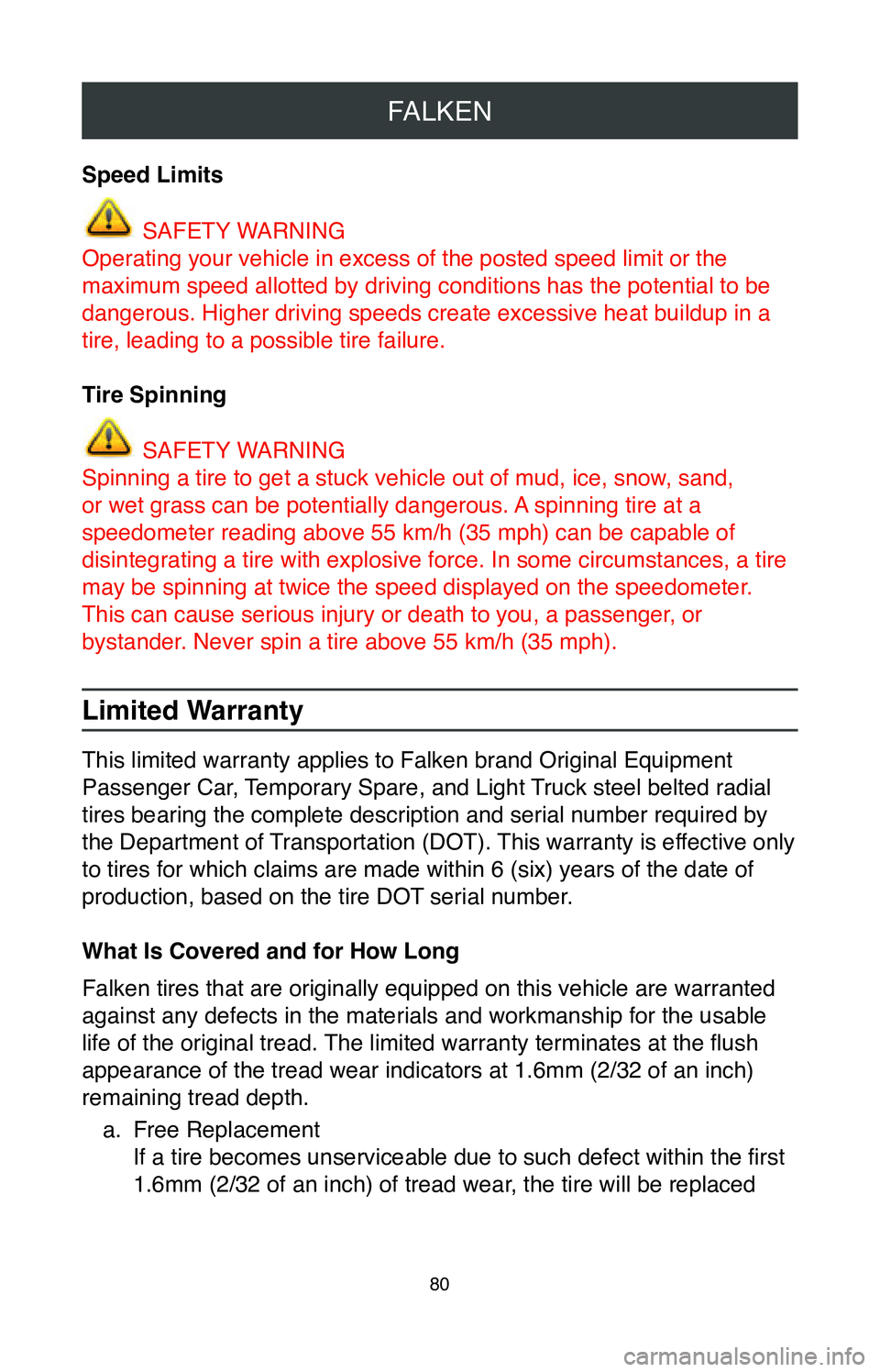
FALKEN
80
Speed Limits
SAFETY WARNING
Operating your vehicle in excess of the posted speed limit or the
maximum speed allotted by driving conditions has the potential to be
dangerous. Higher driving speeds create excessive heat buildup in a
tire, leading to a possible tire failure.
Tire Spinning
SAFETY WARNING
Spinning a tire to get a stuck vehicle out of mud, ice, snow, sand,
or wet grass can be potentially dangerous. A spinning tire at a
speedometer reading above 55 km/h (35 mph) can be capable of
disintegrating a tire with explosive force. In some circumstances, a tir\
e
may be spinning at twice the speed displayed on the speedometer.
This can cause serious injury or death to you, a passenger, or
bystander. Never spin a tire above 55 km/h (35 mph).
Limited Warranty
This limited warranty applies to Falken brand Original Equipment
Passenger Car, Temporary Spare, and Light Truck steel belted radial
tires bearing the complete description and serial number required by
the Department of Transportation (DOT). This warranty is effective only
to tires for which claims are made within 6 (six) years of the date of
production, based on the tire DOT serial number.
What Is Covered and for How Long
Falken tires that are originally equipped on this vehicle are warranted \
against any defects in the materials and workmanship for the usable
life of the original tread. The limited warranty terminates at the flush
appearance of the tread wear indicators at 1.6mm (2/32 of an inch)
remaining tread depth.
a.
Free Replacement
If a tire becomes unserviceable due to such defect within the first
1.6mm (2/32 of an inch) of tread wear, the tire will be replaced
Page 88 of 260
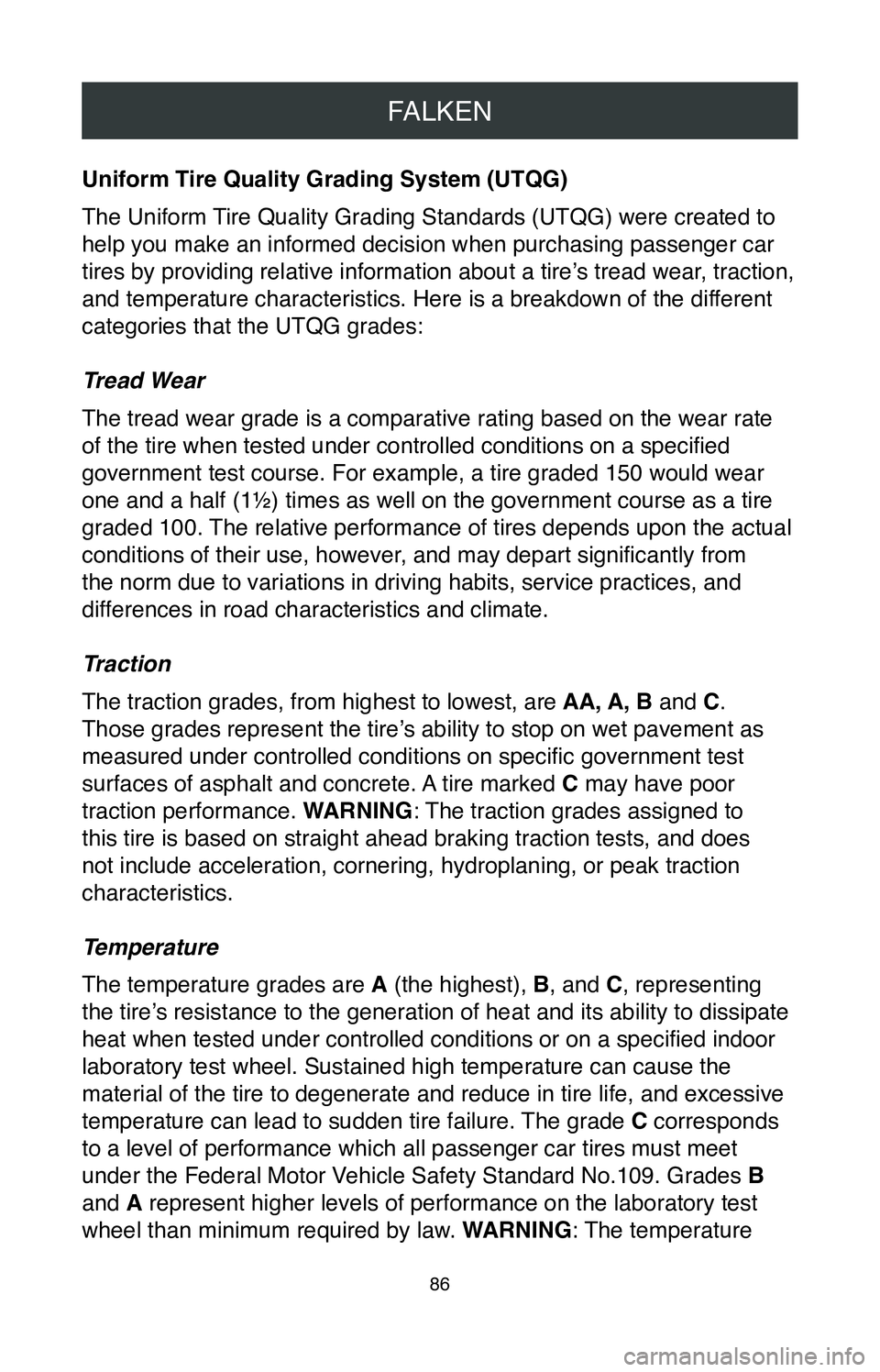
FALKEN
86
Uniform Tire Quality Grading System (UTQG)
The Uniform Tire Quality Grading Standards (UTQG) were created to
help you make an informed decision when purchasing passenger car
tires by providing relative information about a tire’s tread wear, traction,
and temperature characteristics. Here is a breakdown of the different
categories that the UTQG grades:
Tread Wear
The tread wear grade is a comparative rating based on the wear rate
of the tire when tested under controlled conditions on a specified
government test course. For example, a tire graded 150 would wear
one and a half (1½) times as well on the government course as a tire
graded 100. The relative performance of tires depends upon the actual
conditions of their use, however, and may depart significantly from
the norm due to variations in driving habits, service practices, and
differences in road characteristics and climate.
Traction
The traction grades, from highest to lowest, are AA, A, B and C.
Those grades represent the tire’s ability to stop on wet pavement as
measured under controlled conditions on specific government test
surfaces of asphalt and concrete. A tire marked C may have poor
traction performance. WARNING: The traction grades assigned to
this tire is based on straight ahead braking traction tests, and does
not include acceleration, cornering, hydroplaning, or peak traction
characteristics.
Temperature
The temperature grades are A (the highest), B, and C, representing
the tire’s resistance to the generation of heat and its ability to dissipate
heat when tested under controlled conditions or on a specified indoor
laboratory test wheel. Sustained high temperature can cause the
material of the tire to degenerate and reduce in tire life, and excessiv\
e
temperature can lead to sudden tire failure. The grade C corresponds
to a level of performance which all passenger car tires must meet
under the Federal Motor Vehicle Safety Standard No.109. Grades B
and A represent higher levels of performance on the laboratory test
wheel than minimum required by law. WARNING: The temperature
Page 106 of 260
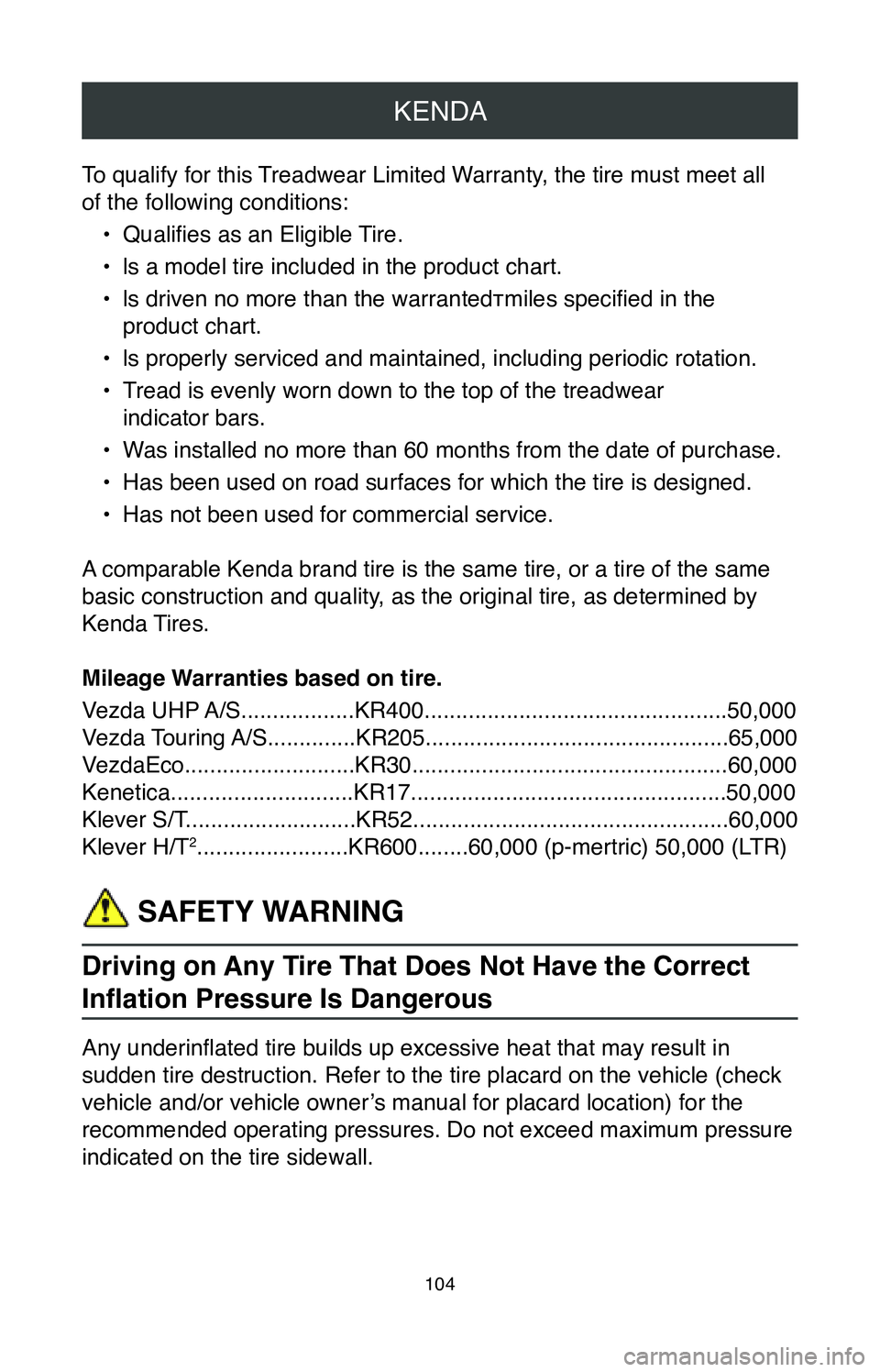
KENDA
104
To qualify for this Treadwear Limited Warranty, the tire must meet all
of the following conditions:•
Qualifies as an Eligible Tire.
•
ls a model tire included in the product chart.
•
ls driven no more than the warrantedтmiles specified in the
product chart.
•
ls properly serviced and maintained, including periodic rotation.
•
Tread is evenly worn down to the top of the treadwear
indicator bars.
•
Was installed no more than 60 months from the date of purchase.
•
Has been used on road surfaces for which the tire is designed.
•
Has not been used for commercial service.
A comparable Kenda brand tire is the same tire, or a tire of the same
basic construction and quality, as the original tire, as determined by
Kenda Tires.
Mileage Warranties based on tire.
Vezda UHP A/S..................KR400.............................................\
...50,000
Vezda Touring A/S..............KR205................................................65\
,000
VezdaEco...........................KR30..................................\
................60,000
Kenetica.............................KR17...............................\
...................50,000
Klever S/T...........................KR52.........................................\
.........60,000
Klever H/T
2........................KR600........60,000 (p-mertric) 50,000 (LTR)
SAFETY WARNING
Driving on Any Tire That Does Not Have the Correct
Inflation Pressure Is Dangerous
Any underinflated tire builds up excessive heat that may result in
sudden tire destruction. Refer to the tire placard on the vehicle (check
vehicle and/or vehicle owner’s manual for placard location) for the
recommended operating pressures. Do not exceed maximum pressure
indicated on the tire sidewall.
Page 119 of 260
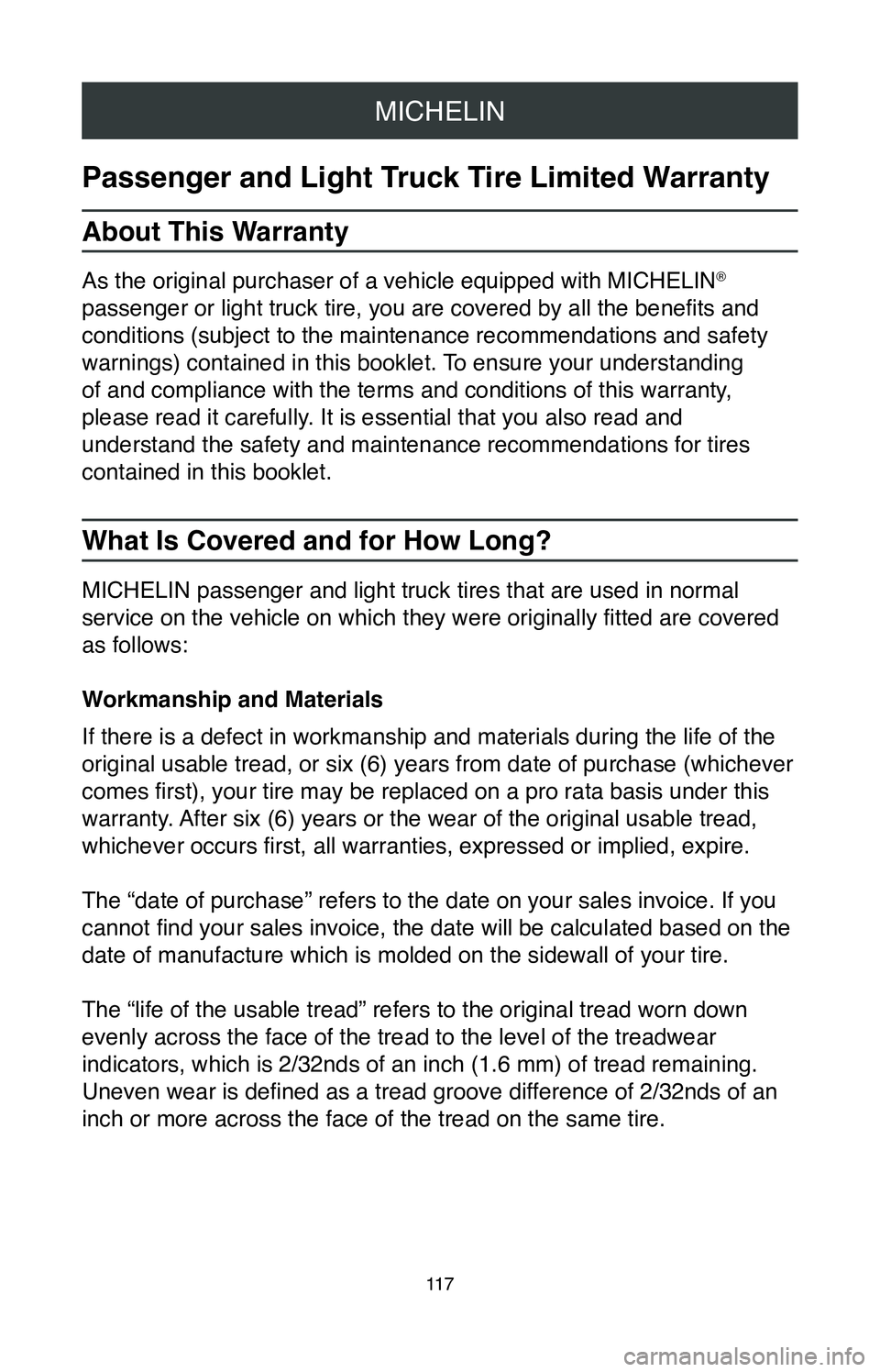
MICHELIN
11 7
Passenger and Light Truck Tire Limited Warranty
About This Warranty
As the original purchaser of a vehicle equipped with MICHELIN®
passenger or light truck tire, you are covered by all the benefits and
conditions (subject to the maintenance recommendations and safety
warnings) contained in this booklet. To ensure your understanding
of and compliance with the terms and conditions of this warranty,
please read it carefully. It is essential that you also read and
understand the safety and maintenance recommendations for tires
contained in this booklet.
What Is Covered and for How Long?
MICHELIN passenger and light truck tires that are used in normal
service on the vehicle on which they were originally fitted are covered
as follows:
Workmanship and Materials
If there is a defect in workmanship and materials during the life of the\
original usable tread, or six (6) years from date of purchase (whichever
comes first), your tire may be replaced on a pro rata basis under this
warranty. After six (6) years or the wear of the original usable tread,
whichever occurs first, all warranties, expressed or implied, expire.
The “date of purchase” refers to the date on your sales invoice. I\
f you
cannot find your sales invoice, the date will be calculated based on the
date of manufacture which is molded on the sidewall of your tire.
The “life of the usable tread” refers to the original tread worn d\
own
evenly across the face of the tread to the level of the treadwear
indicators, which is 2/32nds of an inch (1.6 mm) of tread remaining.
Uneven wear is defined as a tread groove difference of 2/32nds of an
inch or more across the face of the tread on the same tire.
Page 120 of 260
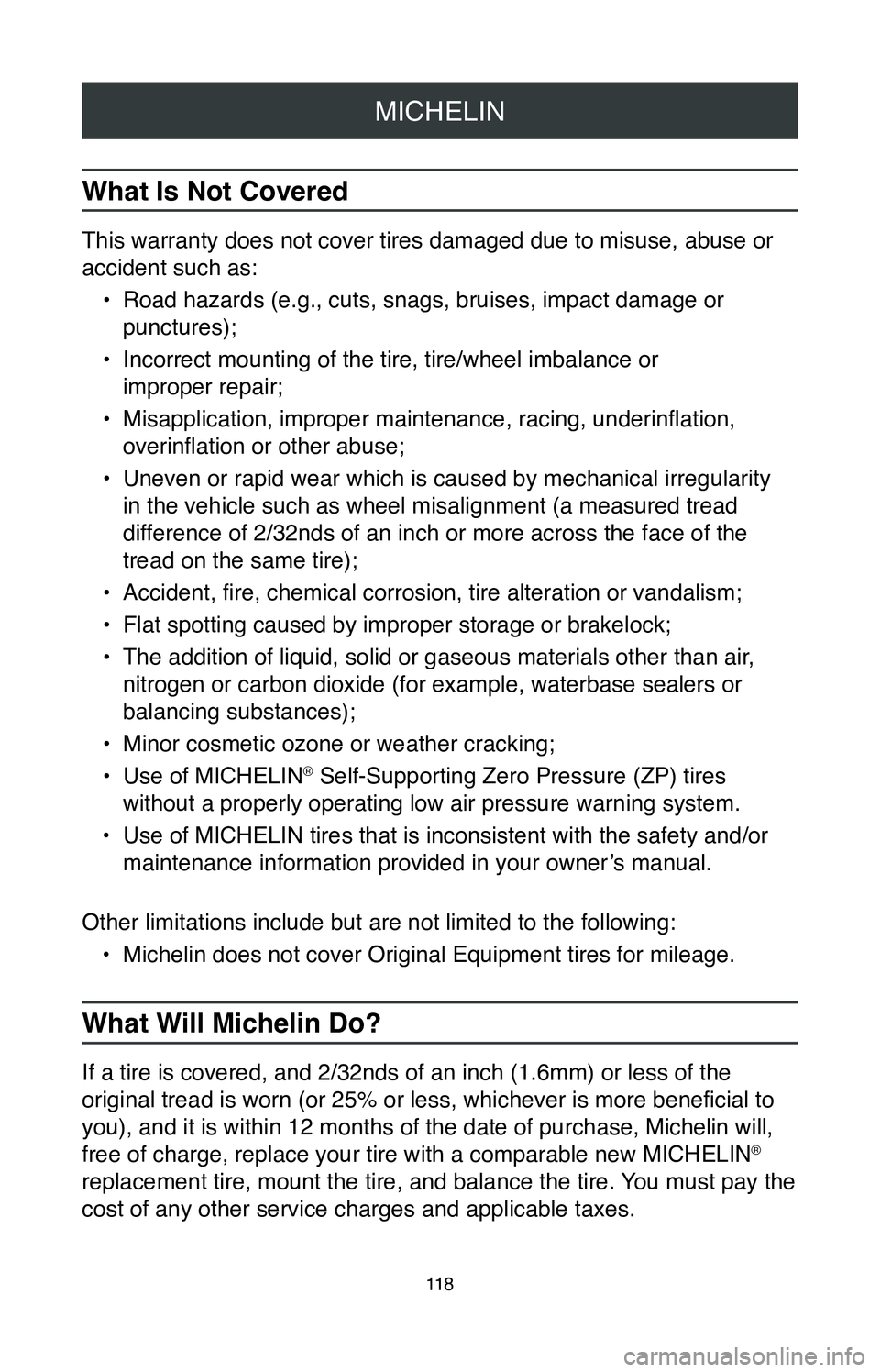
MICHELIN
11 8
What Is Not Covered
This warranty does not cover tires damaged due to misuse, abuse or
accident such as:•
Road hazards (e.g., cuts, snags, bruises, impact damage or
punctures);
•
Incorrect mounting of the tire, tire/wheel imbalance or
improper repair;
•
Misapplication, improper maintenance, racing, underinflation,
overinflation or other abuse;
•
Uneven or rapid wear which is caused by mechanical irregularity
in the vehicle such as wheel misalignment (a measured tread
difference of 2/32nds of an inch or more across the face of the
tread on the same tire);
•
Accident, fire, chemical corrosion, tire alteration or vandalism;
•
Flat spotting caused by improper storage or brakelock;
•
The addition of liquid, solid or gaseous materials other than air,
nitrogen or carbon dioxide (for example, waterbase sealers or
balancing substances);
•
Minor cosmetic ozone or weather cracking;
•
Use of MICHELIN® Self-Supporting Zero Pressure (ZP) tires
without a properly operating low air pressure warning system.
•
Use of MICHELIN tires that is inconsistent with the safety and/or
maintenance information provided in your owner’s manual.
Other limitations include but are not limited to the following: •
Michelin does not cover Original Equipment tires for mileage.
What Will Michelin Do?
If a tire is covered, and 2/32nds of an inch (1.6mm) or less of the
original tread is worn (or 25% or less, whichever is more beneficial to
you), and it is within 12 months of the date of purchase, Michelin will\
,
free of charge, replace your tire with a comparable new MICHELIN
®
replacement tire, mount the tire, and balance the tire. You must pay the
cost of any other service charges and applicable taxes.
Page 121 of 260
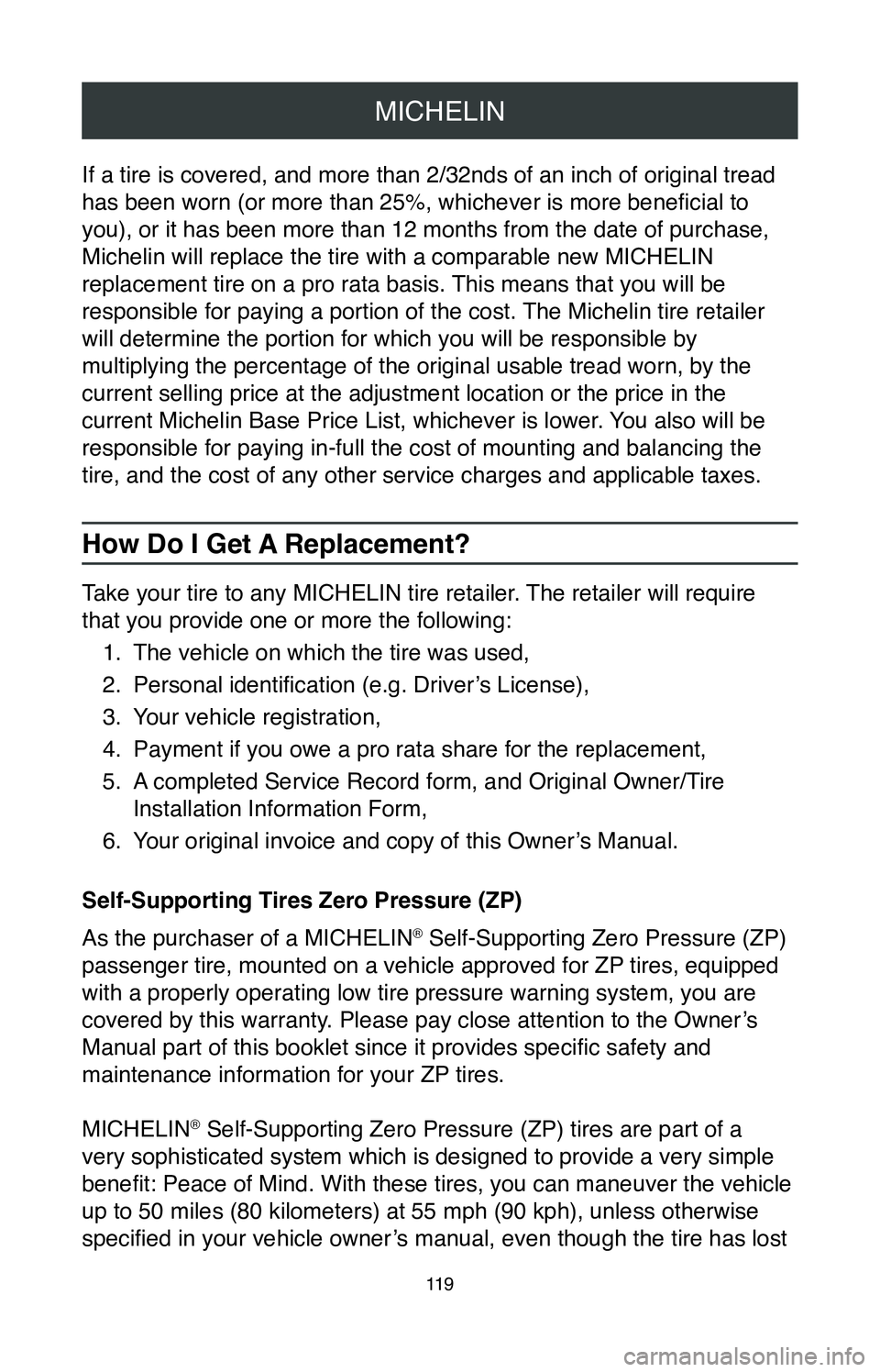
MICHELIN
11 9
If a tire is covered, and more than 2/32nds of an inch of original tread\
has been worn (or more than 25%, whichever is more beneficial to
you), or it has been more than 12 months from the date of purchase,
Michelin will replace the tire with a comparable new MICHELIN
replacement tire on a pro rata basis. This means that you will be
responsible for paying a portion of the cost. The Michelin tire retailer
will determine the portion for which you will be responsible by
multiplying the percentage of the original usable tread worn, by the
current selling price at the adjustment location or the price in the
current Michelin Base Price List, whichever is lower. You also will be
responsible for paying in-full the cost of mounting and balancing the
tire, and the cost of any other service charges and applicable taxes.
How Do I Get A Replacement?
Take your tire to any MICHELIN tire retailer. The retailer will require
that you provide one or more the following:1.
The vehicle on which the tire was used,
2.
Personal identification (e.g. Driver’s License),
3.
Your vehicle registration,
4.
Payment if you owe a pro rata share for the replacement,
5.
A completed Service Record form, and Original Owner/Tire
Installation Information Form,
6.
Your original invoice and copy of this Owner’s Manual.
Self-Supporting Tires Zero Pressure (ZP)
As the purchaser of a MICHELIN
® Self-Supporting Zero Pressure (ZP)
passenger tire, mounted on a vehicle approved for ZP tires, equipped
with a properly operating low tire pressure warning system, you are
covered by this warranty. Please pay close attention to the Owner’s
Manual part of this booklet since it provides specific safety and
maintenance information for your ZP tires.
MICHELIN
® Self-Supporting Zero Pressure (ZP) tires are part of a
very sophisticated system which is designed to provide a very simple
benefit: Peace of Mind. With these tires, you can maneuver the vehicle
up to 50 miles (80 kilometers) at 55 mph (90 kph), unless otherwise
specified in your vehicle owner’s manual, even though the tire has lost
Page 125 of 260
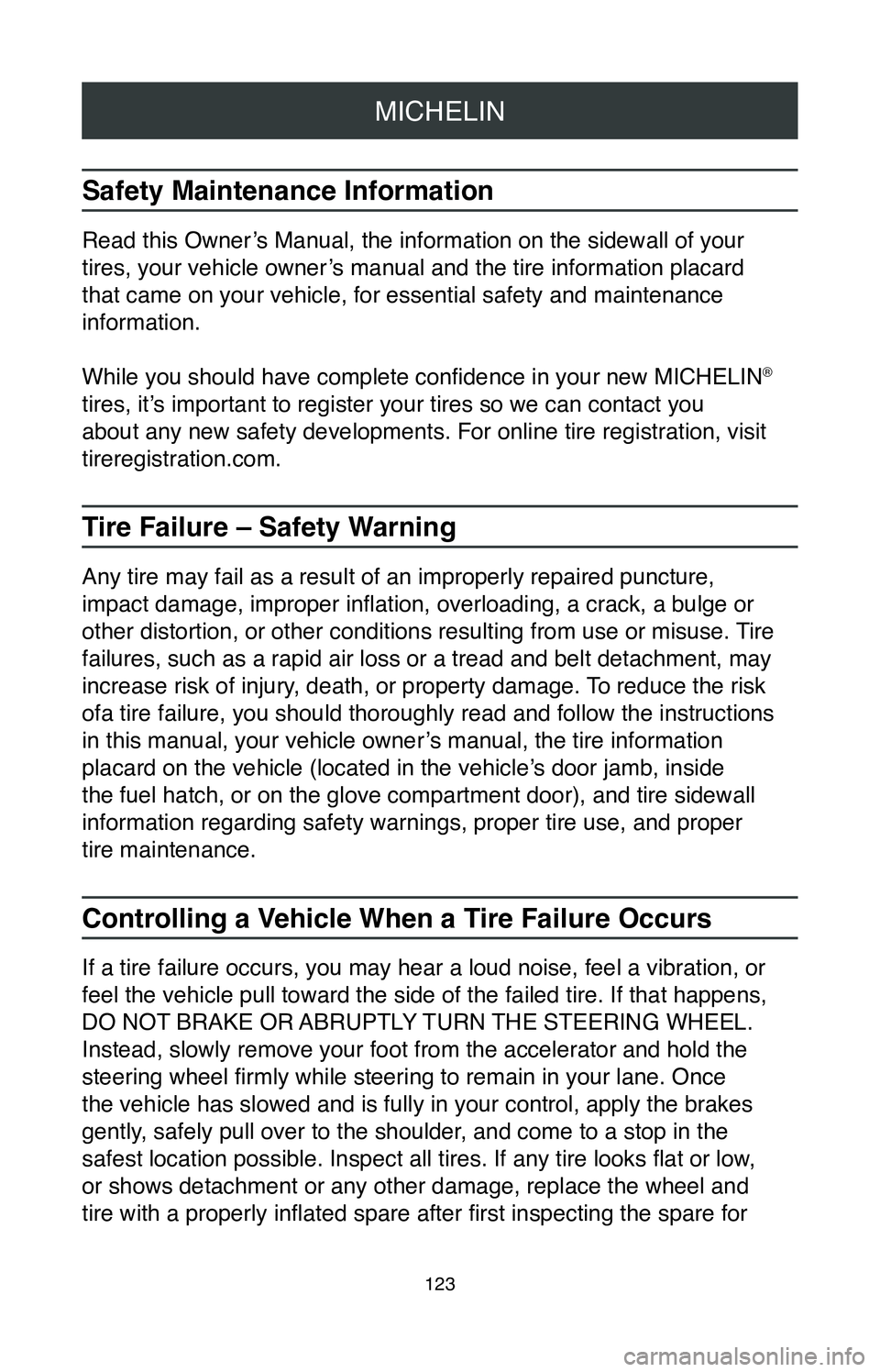
MICHELIN
123
Safety Maintenance Information
Read this Owner’s Manual, the information on the sidewall of your
tires, your vehicle owner’s manual and the tire information placard
that came on your vehicle, for essential safety and maintenance
information.
While you should have complete confidence in your new MICHELIN
®
tires, it’s important to register your tires so we can contact you
about any new safety developments. For online tire registration, visit
tireregistration.com.
Tire Failure – Safety Warning
Any tire may fail as a result of an improperly repaired puncture,
impact damage, improper inflation, overloading, a crack, a bulge or
other distortion, or other conditions resulting from use or misuse. Tire
failures, such as a rapid air loss or a tread and belt detachment, may
increase risk of injury, death, or property damage. To reduce the risk
ofa tire failure, you should thoroughly read and follow the instructions\
in this manual, your vehicle owner’s manual, the tire information
placard on the vehicle (located in the vehicle’s door jamb, inside
the fuel hatch, or on the glove compartment door), and tire sidewall
information regarding safety warnings, proper tire use, and proper
tire maintenance.
Controlling a Vehicle When a Tire Failure Occurs
If a tire failure occurs, you may hear a loud noise, feel a vibration, o\
r
feel the vehicle pull toward the side of the failed tire. If that happen\
s,
DO NOT BRAKE OR ABRUPTLY TURN THE STEERING WHEEL.
Instead, slowly remove your foot from the accelerator and hold the
steering wheel firmly while steering to remain in your lane. Once
the vehicle has slowed and is fully in your control, apply the brakes
gently, safely pull over to the shoulder, and come to a stop in the
safest location possible. Inspect all tires. If any tire looks flat or low ,
or shows detachment or any other damage, replace the wheel and
tire with a properly inflated spare after first inspecting the spare for